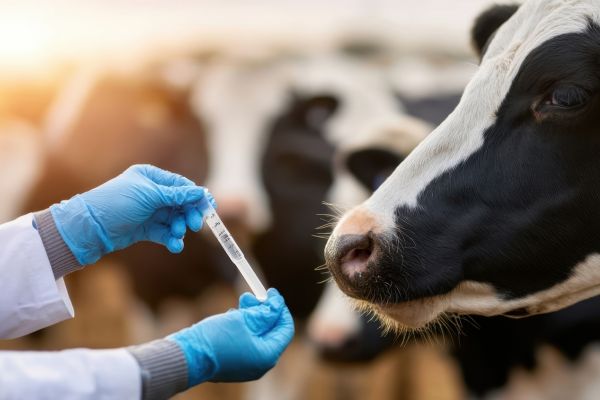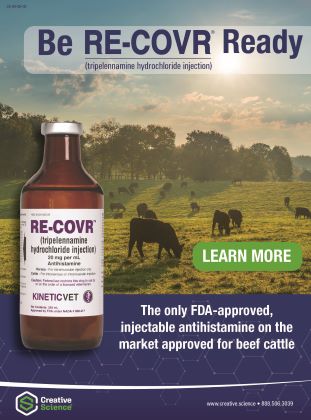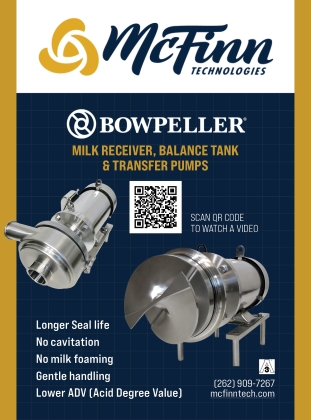Assessing and Implementing a Biosecurity Plan

While there are many ways to prevent and control cattle disease, management with a solid biosecurity plan is a key factor. Implementing biosecurity practices on a dairy can increase profitability by reducing clinical disease and improving production efficiency. Controlling disease will reduce risk at minimal cost. Biosecurity is your first line of defense, which prevents new diseases from entering your farm; biocontainment measures aim to limit the spread of disease within your herd and hence financial losses following the introduction of disease onto your farm once biosecurity has been breached.
While there are many ways to prevent and control cattle disease, management is increasingly recognized as a key factor. Biosecurity is one management strategy that producers can view as insurance from disease. Implementing biosecurity practices on a dairy can increase profitability by reducing clinical disease and improving production efficiency. Controlling disease will reduce risk at minimal cost.
Common Dairy Diseases
Sickness and diseases cause some big headaches for dairy farmers. It can be challenging when it comes to keeping herds healthy. In the dairy industry, one of the top concerns is Johne’s disease. One of the reasons we dread it is because it is a stealthy, long-term problem. It’s caused by a bacterium that infects a cow’s gut, leading to weight loss, chronic diarrhea, and eventually, a big drop in milk production. It can be passed from cow to cow and to other farms, and often it means the cow has to be culled.
Then we have Bovine Viral Diarrhea Virus (BVDV). This one can be tough to pinpoint and diagnose right away because it can show up in so many ways. It might cause issues with pregnancies, like abortions or calves being born with defects. It also weakens a cow’s immune system, making her more vulnerable to other illnesses. So, BVDV can really throw off your dairy, and can go undiagnosed for a while as the disease grows and spreads. It can really wreck a farm’s breeding program and overall herd health.
Salmonellosis is another nasty disease that causes severe diarrhea and fever, especially in young calves. It can spread quickly and lead to a lot of sick animals, sometimes even death. Plus, it’s one of those diseases that can potentially jump from animals to humans, which adds another layer of concern.
Bovine Tuberculosis is a more chronic issue, primarily affecting the lungs. Cows might look a bit off, lose weight, and produce less milk. It’s a serious one because of its impact on the animals and the potential for it to spread to people.
Leptospirosis is another big one for reproductive problems. If it hits a herd, you might see more abortions, stillbirths, and cows having trouble getting pregnant. It can also reduce milk production, which affects your bottom line and the productivity of your farm.
One of the biggest problems shows up as Mastitis. This is probably the most common and costly disease on dairy farms. It’s an inflammation of the udder, and it makes the milk quality go down, reduces how much milk a cow gives, and often means extra vet bills. It’s a constant battle for farmers to keep this under control.
Finally, let’s not forget about the various bacterial infections that lead to lameness. When a cow has sore feet from something like foot rot or digital dermatitis, she’s not going to want to move around much. This means she might not eat or drink enough, her milk production drops, and she might struggle to get pregnant. When left untreated, as we all know, we can quickly lose a cow.
Most of these diseases can be spread by people, including truckers or visitors, vehicles, and other cattle. They aren’t just minor inconveniences; they can really hit a farm’s bottom line by making cows sick, reducing milk production, and even leading to animals needing to be culled. When it comes to disease, it’s easier to put in some preventative measures rather than try and fight the disease. For this reason, you should implement at least some kind of biosecurity plan.
How Daily Farm Life Can Spread Disease
Unless we are intentionally thinking about our biosecurity, it is easy to go about farm life and forget that everyday chores contribute to compromising the biosecurity on the farm. For instance, when we are bringing new cattle into an existing herd, it is one of the biggest risks for introducing new diseases. Any new animal, no matter how healthy it looks, could be carrying something your current herd isn’t immune to, like Johne’s disease or Bovine Viral Diarrhea Virus (BVDV). Failing to quarantine new cattle significantly increases this risk. If you don’t give new cows their own separate space for a few weeks, any illness they might be incubating (meaning it’s present but not yet showing symptoms) will directly expose your existing herd, potentially leading to a rapid spread of infection and disease.
Not requiring disease testing before introducing cattle is a major missed opportunity for prevention. Without testing for common diseases like Johne’s, BVDV, or Bovine Tuberculosis, you might unknowingly bring an unwanted pathogen into your herd, which could unleash a costly and difficult-to-control outbreak.
Similarly, failing to require vaccination before introducing cattle leaves your entire herd vulnerable. Unvaccinated animals are more susceptible to diseases already present on your farm, and if they’re carrying something, they can more easily spread it without the protection a vaccine provides. Vaccinations protect individual animals and also contribute to herd immunity, which slows down or stops disease spread. So do not skip vaccinations on your farm, and quarantine and vaccinate new cattle.
If you have show cattle, even 4-H and FFA cattle, allowing them to return from fairs and shows without isolation is a direct pathway for external germs to enter your farm. Fairs are essentially disease melting pots where animals from various farms mingle and share common spaces, allowing for easy transmission of pathogens. We can also get these diseases from beef cattle present at the fairs.
Additionally, wildlife and other animals in contact with cattle, feed, or water can also introduce diseases. Wild birds, rodents, pets, or even neighboring farm animals can carry various diseases, like Leptospirosis from wildlife, and contaminate feed, water troughs, or the cows themselves. Leptospirosis is a bacterial disease that can affect humans as well as other livestock, and even farm dogs. The symptoms can range from a mild, flu-like illness to a severe, potentially fatal condition.
Disease spread through people, vehicles, or equipment is a significant concern. If a vet, feed truck, or even farm staff visit a sick farm and don’t properly clean and disinfect their boots, tires, or tools before entering your farm, they can easily track in pathogens.
Herd Risk Factors
Using multiple cow maternity housing can unintentionally promote disease spread. Calving is a vulnerable time, and if multiple cows share the same space without thorough cleaning between uses, pathogens like Salmonella or E. coli can easily transfer from one cow and calf to the next.
While it might be convenient, try to refrain from using the calving area for sick cows. This turns the maternity pen into an infection hotspot, exposing vulnerable newborns to high levels of pathogens right when they are most susceptible.
Failing to separate sick from healthy cows is fundamental to disease control. A sick cow can easily transmit pathogens through coughing, shedding bacteria in her feces, or direct contact, leading to wider herd infection. One of the first steps to implementing a biosecurity system is to quarantine sick cattle.
One thing that is for sure: if you have a dairy, you have manure. Using manure-handling equipment to mix feed or feed cows creates a direct pathway for fecal-oral transmission. If a loader used for manure is then used for feed, it can contaminate the feed with bacteria like Salmonella or Mycobacterium avium subspecies paratuberculosis (Johne’s). Manure-contaminated drinking water is a perfect medium for spreading disease. Cows drinking water contaminated with feces can ingest pathogens like E. coli or Giardia, leading to widespread digestive issues.
Along similar lines, feeding contaminated feeds, such as moldy feed, feed that’s been in contact with wildlife droppings, or feed mixed with contaminated equipment, can introduce a host of digestive and other health problems to the herd.
Contact with other cows, feed, or water within the herd specifically refers to direct contact between animals through shared spaces, licking, or simply breathing the same air in close quarters. This allows for easy transmission of respiratory and other diseases already present on the farm.
When you do have a sick cow quarantined, you need to be mindful of the sick cow and the area. Sickness can spread via people, vehicles, or equipment within the farm, and can also move pathogens from one area to another. For example, moving between sick pens and healthy pens without proper disinfection, or staff not changing boots or clothes, can easily spread pathogens.
Finally, while teat dip, dry cow treatment, and udder hygiene are crucial preventative measures, if these practices can actually introduce mastitis-causing bacteria directly into the udder or fail to prevent new infections, creating a risk point rather than a protective one. Be mindful of cattle with Mastitis and use a separate dip to avoid cross-contamination.
When it comes to biosecurity and managing disease on a dairy farm, it is a complex and continuous effort. Dairymen have to be conscious and intentional about what enters the farm, how animals interact, and how daily tasks are performed.
Implementing a Biosecurity Plan
It involves a lot of effort in terms of biosecurity to keep a dairy healthy and running smoothly. You should evaluate and assess the risks on your own farm. First, you should identify and rank the specific infectious diseases that pose the greatest risk to your particular dairy operation. This might be regional or differ depending on your on-farm and off-farm activities. This involves evaluating both the likelihood of an outbreak and the potential severity of its consequences relative to your dairy’s overall goals, whether those are focused on milk production, calf health, or herd health. Consider all the ways diseases could potentially enter your dairy. This should consider every possible entry point, from the introduction of new animals and the presence of visitors to shared equipment and even wildlife interactions. Understanding these pathways is key to implementing effective barriers.
Next, you’ll need to design and implement a biosecurity program that is specifically tailored to meet your dairy’s unique goals and address the precise risks you’ve identified. Don’t be overwhelmed by this. A good start is with a consistent vaccination program and being quick to spot and treat any issues that pop up. You should also, as discussed, have a designated sick pen or area to quarantine sick cattle and prevent the spread of disease. Be sure to exercise top-notch hygiene and disinfect tools, clothing, and equipment that comes in contact with sick cattle. Remember, you do not want to contribute to the spread of disease on your farm or to another farm. Quarantine new cattle, and consider the traffic coming and going from your farm.
Lastly, communication is vital. If you have sickness or illnesses on your farm. Let your neighbors and people entering your farm know. Your neighbors might need to assess their shared fence rows and run a hot wire to discourage cattle from coming into contact with infected cattle. As you begin to implement the easy changes, you can re-evaluate, change, and grow your biosecurity plan.
By Jessica Graham
Click here for more information: https://americandairymen.com/



